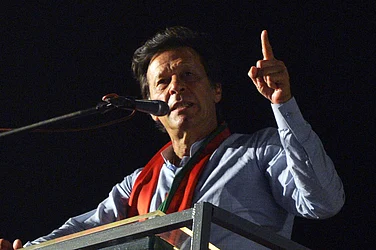The Hamas assault on Israeli communities in south west Israel changed the Middle East strategic picture with a single stroke. Until October 7, 2023, the general trend in the region had appeared to be moving toward a certain uneasy stability. The unrest of the 2010-19 period, mistakenly initially termed the ‘Arab Spring’, had begun to recede. Its main outcome had been the fragmentation and partial collapse of governance in a number of Arab states—Yemen, Iraq and Syria most important among them. But the emergence of dangerous non-state actors, the Islamic State organisation and others, appeared to have been largely curtailed.
Two broadly identifiable power blocs existed in the region. These were, firstly, the regional bloc led by the Islamic Republic of Iran. This group of anti-western and anti-stability forces includes Iran itself, its client Hizballah organisation in Lebanon, the Bashar Assad regime in Syria, the Houthis or Ansar Allah movement in Yemen, the Shia militias of Iraq (who underwrite the current Iraqi government), and the Islamic Jihad and Hamas movements among the Palestinians.
Facing this united and well-crystallised bloc was a more loosely aligned group of countries broadly identified with a pro-western alignment. Among this group would be included Israel, the United Arab Emirates, Egypt, Saudi Arabia, Morocco and Bahrain as the core components, along with a number of non-state actors such as the Kurdish autonomous areas in Iraq and Syria. Unlike the pro-Iran group, which for the most part share a certain ideological outlook (political Islam), and an orientation in terms of governance (authoritarianism), this more loosely defined group do not share forms of administration or political culture. They have in common shared concerns regarding the intentions of the Iranian bloc, and regarding political Islam.
Many analysts had concluded in recent months that despite the sharp differences between elements of these blocs (most importantly, between Israel and Iran), the region appeared to be moving toward a certain equilibrium. China had brokered a rapprochement between Iran and Saudi Arabia which had secured the resumption of full diplomatic relations between the two countries. Israel had resumed full diplomatic relations with Turkey, after a decade of tensions. The outlier to this perception of slow diplomatic progress was Israel-Iran.
Teheran remained committed to the goal of the destruction of Israel. But here, it seemed, Iran’s clients closest to Israel were deterred. Despite Iran client Hizballah’s domination of Lebanon, an agreement demarcating maritime borders was reached between Israel and Lebanon in 2022. Regarding Hamas- controlled Gaza, the growing perception was that the movement, despite its ideological Islamist convictions, had been effectively deterred by Israel’s military power. A system whereby Qatari money was delivered to the Gaza Strip to keep it economically afloat had been put in place. Nearly 17,000 permits for Gazan workers to work in Israel had been issued.
So at least for the short term, and in spite of the deep and irreconcilable differences deriving from Iranian regional ambitions, a certain stability appeared to have been achieved. This, of course, turned out on October 7 to be an illusion. What were the underlying factors that those who proclaimed this new period of stability had missed?
There were two related factors. The first and perhaps still least remarked upon is the continued popularity of political Islam at the grassroots level throughout a large swathe of the majority Sunni Muslim Arab world, but at the same time the defeat or marginalisation of all the projects that Sunni political Islam had produced over the last decade.
From Egypt to Iraq, and taking in Israel/West Bank/Gaza, Jordan, Lebanon and Syria, Islamist movements have attempted to raise a number of political projects over the last decade—the Muslim Brotherhood government in Egypt, the Hamas election victory in the Palestinian territories, the Sunni insurgency in Syria, the Islamic State in Iraq and Syria—but all these projects have been defeated and marginalised. As a result, over the last half decade, attention turned to state-led diplomatic processes from above and began to ignore the continued vigour and popularity of Islamist ideas and organisations at the grassroots level.
The second factor that was ignored was the un-reconciled and radical nature of the Iranian regional project, which seeks to overturn the regional order, and for whom war against Israel is a tool of policy. Hamas represents Islamist will from below in the Palestinian context. The Iranian military assistance to Hamas over an extended period of time afforded it with the military capacities that were on display on October 7. The Hamas offensive of that day was the meeting of these two factors and it returned them to centre stage in the Middle East after a half-decade of illusions.
So what’s happening now? The Israeli response so far has been to mobilise 360,000 reservists and to begin an air campaign over Gaza. The assumption remains that this air campaign is intended as a prelude to an extensive ground offensive into the Gaza Strip, as has been confirmed by Defence Minister Yoav Gallant in public statements. The goal of such a ground offensive would be to bring down the Hamas government, which has ruled the Gaza Strip since 2007.
In the meantime, other elements of the Iran-led alliance of which Hamas is a part have mobilised, and partially entered the fray. Hizballah is now carrying out attacks on the northern border on a daily basis, using anti-tank rockets and missiles. Iraqi and Syrian Shia militias have carried out attacks on US forces. Even the Houthis in Yemen tried to launch a series of drones and cruise missiles in Israel’s direction on October 18.
The United States, meanwhile, has sent an aircraft carrier group to the Mediterranean, with the clear purpose of deterring Iran and Hizballah from taking more decisive action.
The result of all this has been severe disruption to the lives of both ordinary Israelis and ordinary Gazans. For Israelis, the slaughter of 1,400 people by an armed mob has strong historical resonances. Most Israelis are the descendants of Jewish refugees—from Europe, Western Asia and North Africa. The experience of displacement, massacres, and helplessness is within the living memory of many families, and within the inheritance of nearly all.
The promise of the independent State of Israel was that while there might be risk involved in the maintenance and defence of Jewish sovereignty, the kind of helplessness and defencelessness which Jews experienced in the Diaspora would not be a part of Israeli life. For the most part, in the 75 years of sovereignty, that pledge has been fulfilled. The events of October 7, however, were a serious falling short. Watching the scenes of armed men going from house to house, executing and burning innocent civilians, including women and children, has revived many historic traumas. This has led to widespread public support for the government’s stated goal of destroying the Hamas quasi-sovereignty in Gaza.
For the Palestinian residents of Gaza, the Israeli aerial response to the massacre of October 7 is bringing widespread suffering. Israel, unlike Hamas which purposely seeks civilian life, has sought to warn residents of Gaza to make their way south of the Gaza River, while Israel attacks Hamas targets in the north of the Strip. Inevitably, however, many have remained, with some reports suggesting that the Hamas authorities in Gaza have deliberately prevented civilians from making their way southwards to safety. The result has been suffering and loss of life, for an indeterminate number.
So where is all this heading? The Israeli media is still talking about an imminent ground operation to bring down the Hamas governing authority in the Gaza Strip. Yet 18 days into the war, no ground manoeuvre has yet begun. There are growing voices suggesting differences over the next steps. While the IDF and Defence Minister Gallant are pushing for an early and comprehensive entry into Gaza with this objective, the pattern of events suggests that the United States does not favour this, and Israeli Prime Minister Benjamin Netanyahu has shown throughout his career a reluctance to make use of Israel’s ground forces in large-scale maneuvers.
There are around 220 Israeli hostages inside Gaza, including infants and elderly. These include American and other foreign citizens. The implications of an all-out assault on Gaza would be grave for these individuals. Four hostages have been released and have reported that they were held underground, in the extensive tunnel system which Hamas has constructed beneath the Strip and which would be the main target in any Israeli attempt to root out Hamas in Gaza. The Focus now appears to be centring on efforts to free these prisoners. In the north, Hizballah is continuing its daily attacks. It has lost 39 from among its fighters over the last two weeks. Seven IDF troops have also been killed in the north. There has been severe disruption to the lives of residents of northern Israel, with 28 communities evacuated.
Everything currently appears to be in a kind of holding pattern. Israel has recruited a large force and assembled it on the border, but there appear to be divisions and uncertainty regarding the next moves. Hizballah and Iran behind it seem to want to continue a steady rhythm of limited attacks on Israel’s northern border, while avoiding a deterioration to a general conflict.
The US has sent an aircraft to deter Hizballah and Iran and has itself downed missiles and drones launched at Israel from Yemen. It appears to prefer a more limited Israeli counterstrike to that favoured by the Israeli military. What will happen next cannot be precisely predicted. What may be stated with confidence is that the war which commenced with the Hamas attacks of October 7 is far from over and there is much suffering yet to come.
(Views expressed are personal)
Jonathan Spyer is a journalist, author and analyst of Middle East affairs
(This appeared in the print as 'Uncertain Future')





















